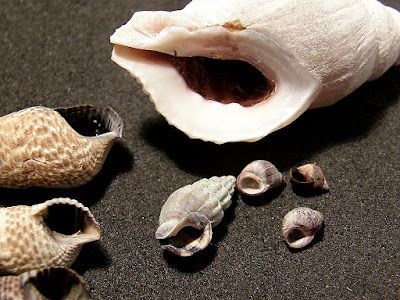Japanese nassa, Nassarius fraterculus, aka. Hima fratercula
I am used to seeing snails there; mostly periwinkles, and an occasional whelk. They usually show the foot and two thin, pointy tentacles. Sometimes the eyes, at the base of the tentacles, are visible. But this long, thick siphon, half as long as the entire snail? I had not seen that before.
The snail was wandering around, "sniffing" with the siphon, waving it about, poking it into crevices, under shells and stones.
I went through all the entries in Kozloff's index for "sea snail", and finally found this:
Amphissa columbiana ... The almost elliptical aperture is bordered on the inner side by a conspicuous enameled area, and there is a distinct notch -- almost a canal -- through which the snail sticks out its long siphon.The accompanying photo showed a snail somewhat similar to mine, with a short siphon, protruding barely beyond the tentacles. Still, it was close, and I had been thinking that the shell looked Amphissa-like. I reviewed my photos, and found that "canal" in the aperture:
Foot, tentacles, siphon, one eye. Green and white body. The dark smudge at the back is the operculum on the top of the foot.
Why hadn't I noticed that notch in the aperture before? (Maybe because I wasn't looking?) How does it compare to those of other species? I dug out a few shells from local snails to see:
The whelk and the nassa have distinct canals, and a spread lip. The mud snails have a bit of a notch, no lip. And the periwinkles' aperture is a fat teardrop shape, with no provision made for the siphon. The "V" at the other end is the anal notch; they all have it.
A handy diagram of sea snail anatomy is at the bottom of this page. (Translated from the German. Main snail page, with links, untranslated.)
The hermit? He hid while I looked at the snail. I'll find him another day.
.




No comments:
Post a Comment
I'm having to moderate all comments because Blogger seems to have a problem notifying me. Sorry about that. I will review them several times daily, though, until this issue is fixed.
Also, I have word verification on, because I found out that not only do I get spam without it, but it gets passed on to anyone commenting in that thread. Not cool!